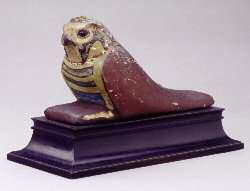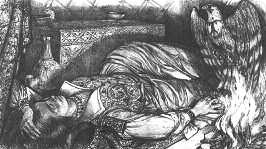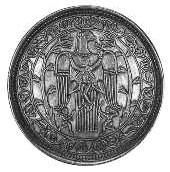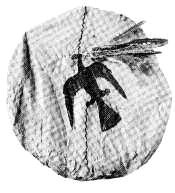Falcon (7 page)


Hundreds of thousands of falcons in ancient Egypt were mummified and given as votive offerings to the gods. Dipped into tar, or preserved with natron, their bodies were placed in a suitable receptacle or coffin before being passed to the shrine priest to be entombed on the devotee’s behalf in mass inter- ment ceremonies. The temple of Nectanebo ii at Saqqara,
dedicated to Isis, the mother of Horus, contained 100,000 mummified votive falcons stored in galleries, stacked in rows of jars separated by layers of sand. Temple priests bred some sacred animals such as cats and ibises specifically for the pur- pose of interment, but falcons are difficult to breed in captivity; the Horus cult must have had significant impact on wild falcon populations in the region. The trade in falcons was extensive, and while most of these offerings were indeed local falcon species such as kestrels and lanners, many weren’t: kites, vul- tures and even small songbirds were also interred. Perhaps these were fakes, fraudulently sold to devotees in an ancient deception revealed – along with the birds’ frail bones – centuries later by x-ray and magnetic resonance imaging.
falcon cults
Striking parallels exist between the mythico-religious roles of falcons across diverse cultures and over many millennia. As the cult of Horus suggests, falcon-gods are commonly creator-gods and associated with sun or fire. Like Horus, the ancient Iranian fire- and water-god Avestan Xvaranah was depicted as a falcon. Like Horus he was synonymous with the celestial fortune of kings and their divine right to wield authority. God, according to the prophet Zoroaster, had the head of a falcon. The six- teenth-century French falconer Charles D’Arcussia reminded his readers that the ancients thought that the thighbones of peregrines or Sakers attracted gold just as a magnet attracts iron. An apt correspondence, D’Arcussia thought, because ‘the Alchemists . . . attribute golden metal to the sun’. But as a falconer D’Arcussia had a more prosaic explanation. ‘The Ancients did not mean anything more than that flying hawks is
Emeshe, the mythological ancestress of the Magyars, is visited by the falcon Turul in a dream.

a great expense’, he wrote, ‘attracting and consuming much gold from those whose passion for it goes beyond reason.’
11Russian anthropologists have traced the existence of these shared falcon myths to a near-universal cult of birds of prey that once existed across ancient Central Asia. They maintain that trade, invasion, migration and settlement carried elements of this cult eastward and westward over millennia. In addition to seeing falcons as creator gods associated with sun and fire, these ancient myths associate falcons with the human soul; they see falcons as messengers between heaven and earth and between humans and gods. They also associate falcons with marriage and fertility. Falcons populate many legends of the foundation of dynasties and empires. Genghis Khan’s future mother-in-law dreamt that a white falcon holding the sun and moon in its talons flew down from the sky to her hand. She took the vision as a sign that her daughter would marry the future conqueror. Falcons’ association with fertility has its practical uses, too. In parts of Kazakhstan and Kyrgyzstan, trained falcons are tradi- tionally brought inside the yurt during childbirth, for their sharp eyes scare away the demon known as
al-basty
or ‘the Red Mother’ who attacks women in labour and gives them puerperal fever.The legends of the giant
Turul
falcon of Hungarian mythology evince many elements common to this cult of raptors. The
Turul
was often depicted as the sun. It was the symbol of the house of Attila, and the ancestor of the Hungarian Árpád dynasty. In 819 King Béla iii’s royal scribe recorded that the Scythian leader Ügyek married a woman called Emeshe, who bore Álmos, the first of this dynasty of kings:The boy obtained his name because of the unusual cir- cumstances of his birth, when his mother in a vision saw the great Turul descend from heaven on her and made her fertile. A great spring welled forth from her womb and began flowing westward. It grew and grew until it became a torrent, which swept over the snow-covered mountains into the beautiful lowlands on the other side. There the waters stopped and from the water grew a wondrous tree with golden branches. She imagined famed kings were to be born from her descendants, who shall rule not here in their present lands but over that distant land in her dreams, surrounded with tall mountains.
12After this visitation, Emeshe and her son became the first people able to read the will of god from the stars. Like many other elements of this ancient cult, the notion that the first priests were born from the union of a falcon and a woman is firmly located in a shamanic religio-mythical universe. A term borrowed from the Tungus of Siberia, a shaman is a person who can travel between different worlds during ecstatic trances; in these trances, the shaman’s soul leaves his or her body. It can ascend to the upper realms of heaven or down to the under- world; it guides the souls of the dead to heaven, or petitions or
A 7th-century ad Persian silver dish showing a falcon (or perhaps an eagle) carrying a deceased person’s soul to the sky.
Shown as a naked female figure, the soul feeds the bird with the fruits of her good deeds.

negotiates with gods and spirits for knowledge, cures for sick- ness, predictions of the future and so on.
Falcons often feature as an assisting spirit in shamanic tradi- tions.
Haoma
, ‘the drink of immortality’, was used in ancient Zoroastrian sacrificial rituals; there’s a long tradition of using hallucinogens to achieve these ecstatic trances. Reputedly a preparation of the fly agaric mushroom,
Haoma
was stolen from the gods by the falcon and brought to man: falcon images are frequent on ancient Iranian and Persian artefacts and on Achaemenid and Sassanid vessels and weapons. Californian Chumash Indians used the
Datura
plant to allow them to con- tact their personal ‘dream helper’ spirits. In the early twentieth century, Fernando Librado related how the crew of a Chumash sea canoe were all saved through the intercession of the captain’s dream helper, the peregrine, during a storm. Falcons appear as assisting spirits in literature, too: falcons in Serbo-Croatian epic poetry protect their owners by bringing them water in their beaks and shading them from the sun when they are sick.The world tree is a central element in many shamanic cos- mogonies. It bridges heaven, earth and the underworld and often on its topmost branch sits a falcon. The Hungarian
Turul
, for example, perched at the top of the Tree of Life. In Norselegend the falcon was called
Vedfolnir
, ‘blown down’.
Vedfolnir
perched on the beak of the eagle that itself sat on the topmost branch of the world tree
Yggdrasil
. This falcon’s task was to report to Odin everything he saw in the heavens, on earth and below. Related to the falcon atop the world tree is another frequently encountered shamanic symbol: a bird or falcon perched on a stick. The creation myth of Horus of Edfu describes how the world was formed from chaos when two amorphous beings appeared above a tiny island in the primeval sea. One picked up a stick from the shore, snapped it in two and stuck one half into the ground near the water’s edge. A falcon flew out of the darkness and alighted on the stick. Immediately, light broke over chaos, the waters began to recede, and the island grew and grew until it became the earth.
Shamans often transform themselves into birds during their ecstatic trances. In this form they can fly to the world tree to bring back souls as birds, or transport the bird-souls of the recently dead to heaven. The Hungarian
Turul
perched next to the souls of unborn children in the form of birds. As befits shamans with falcon ancestors, shamans can become a falcon on their journeys. Singing chants in honour of the stars, forA Crow Indian painted shield cover from Montana with an image of the warrior’s protect- ing genius, the prairie falcon, and an attached bundle of prairie falcon feathers.
example, Malekula shamans spread their arms to imitate a falcon. And according to North American Plains Indians the falcon was the only animal that knew the location of the hole in the sky through which it could reach God. After being asked whispered questions the falcon flew through the hole in the sky and back to deliver the divine replies to the shaman.
souls and unions
Kushlak, the unwise knight, sold his talking falcon to a stranger in exchange for a herd of horses in the Bashkir epic
Kara yurga.
As the stranger took Kushlak’s falcon onto his hand, it cried: ‘if you give me up, happiness will leave you; prosperity will leave you, your life will leave you. Don’t give me away, Kushlak- batir; do not sell me, Kushlak-batir.’ Ignoring his falcon’s pleas, Kushlak received his herd of horses, and shortly afterwards died. His unlikely death is better understood if we keep in mind the fact that, as D’Arcussia wrote in 1598, ‘ancient people used the Falcon to signify the spirit of man’.
13
Right across pre- Christian and pre-Islamic Eurasia, falcons were associated with the human soul. Ancient Turkic gravestones depict the souls of fallen warriors as falcons perching on their hands. The Egyptian
Book of the Dead
describes the deceased as a falcon flying away – and the Egyptian pharoah could adopt the form of a falcon to visit his mortal body after death.Such associations continue: in some parts of Central Asia killing a falcon is still considered a crime morally equivalent to murder. In the early twentieth century this taboo against harm- ing falcons was still extended to falconers; hurting or humiliating someone carrying a falcon or other bird of prey on the fist was unthinkable. In early twentieth-century California, Karok Indian Three-dollar Bar Billy maintained that anyone who
Other books
What Casanova Told Me by Susan Swan
Captive by Heather Graham
The Master Undone: An Inside Out Novella by Jones, Lisa Renee
The Ruthless Redhead's Revenge by Morrel, Amy
Paying Guests by Claire Rayner
Retratos y encuentros by Gay Talese
Half-Sick of Shadows by David Logan
Omerta (The DeLuca Family #1) by K. A. Ware
Daughter of Nomads by Rosanne Hawke
Soft Serve Secrets: A Cozy Mystery (Caesars Creek Mystery Series Book 3) by Constance Barker
